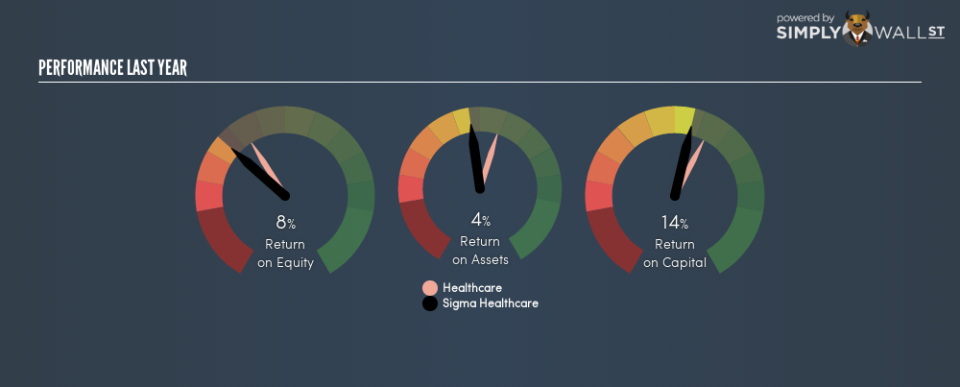Here’s why Sigma Healthcare Limited’s (ASX:SIG) Returns On Capital Matters So Much

Today we are going to look at Sigma Healthcare Limited (ASX:SIG) to see whether it might be an attractive investment prospect. Specifically, we’re going to calculate its Return On Capital Employed (ROCE), in the hopes of getting some insight into the business.
Firstly, we’ll go over how we calculate ROCE. Then we’ll compare its ROCE to similar companies. And finally, we’ll look at how its current liabilities are impacting its ROCE.
Return On Capital Employed (ROCE): What is it?
ROCE measures the ‘return’ (pre-tax profit) a company generates from capital employed in its business. In general, businesses with a higher ROCE are usually better quality. Overall, it is a valuable metric that has its flaws. Author Edwin Whiting says to be careful when comparing the ROCE of different businesses, since ‘No two businesses are exactly alike.’
How Do You Calculate Return On Capital Employed?
Analysts use this formula to calculate return on capital employed:
Return on Capital Employed = Earnings Before Interest and Tax (EBIT) ÷ (Total Assets – Current Liabilities)
Or for Sigma Healthcare:
0.14 = AU$87m ÷ (AU$1.3b – AU$817m) (Based on the trailing twelve months to July 2018.)
So, Sigma Healthcare has an ROCE of 14%.
View our latest analysis for Sigma Healthcare
Want to help shape the future of investing tools and platforms? Take the survey and be part of one of the most advanced studies of stock market investors to date.
Is Sigma Healthcare’s ROCE Good?
ROCE can be useful when making comparisons, such as between similar companies. Using our data, we find that Sigma Healthcare’s ROCE is meaningfully better than the 11% average in the Healthcare industry. We would consider this a positive, as it suggests it is using capital more effectively than other similar companies. Separate from Sigma Healthcare’s performance relative to its industry, its ROCE in absolute terms looks satisfactory, and it may be worth researching in more depth.
When considering this metric, keep in mind that it is backwards looking, and not necessarily predictive. Companies in cyclical industries can be difficult to understand using ROCE, as returns typically look high during boom times, and low during busts. This is because ROCE only looks at one year, instead of considering returns across a whole cycle. What happens in the future is pretty important for investors, so we have prepared a free report on analyst forecasts for Sigma Healthcare.
How Sigma Healthcare’s Current Liabilities Impact Its ROCE
Liabilities, such as supplier bills and bank overdrafts, are referred to as current liabilities if they need to be paid within 12 months. The ROCE equation subtracts current liabilities from capital employed, so a company with a lot of current liabilities appears to have less capital employed, and a higher ROCE than otherwise. To counteract this, we check if a company has high current liabilities, relative to its total assets.
Sigma Healthcare has total liabilities of AU$817m and total assets of AU$1.3b. Therefore its current liabilities are equivalent to approximately 62% of its total assets. This is admittedly a high level of current liabilities, improving ROCE substantially.
The Bottom Line On Sigma Healthcare’s ROCE
This ROCE is pretty good, but remember that it would look less impressive with fewer current liabilities. But note: Sigma Healthcare may not be the best stock to buy. So take a peek at this free list of interesting companies with strong recent earnings growth (and a P/E ratio below 20).
For those who like to find winning investments this free list of growing companies with recent insider purchasing, could be just the ticket.
To help readers see past the short term volatility of the financial market, we aim to bring you a long-term focused research analysis purely driven by fundamental data. Note that our analysis does not factor in the latest price-sensitive company announcements.
The author is an independent contributor and at the time of publication had no position in the stocks mentioned. For errors that warrant correction please contact the editor at editorial-team@simplywallst.com.

 Yahoo Finance
Yahoo Finance 
